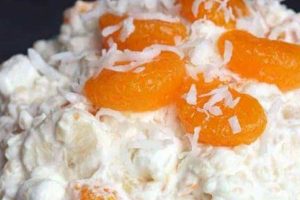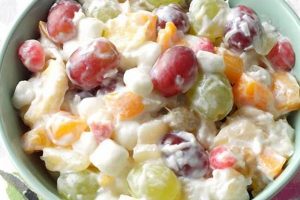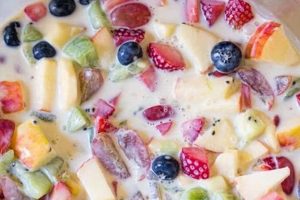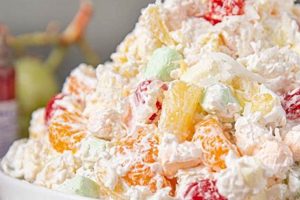A combination of fruits characteristic of the fall harvest season, typically including apples, pears, grapes, and pomegranates, forms the basis of a seasonally inspired salad. Variations might incorporate nuts, cheeses, or leafy greens, and dressings often feature maple syrup, honey, or citrus juices to complement the fruit’s sweetness. For example, a simple version could involve diced apples and pears tossed with red grapes, pomegranate arils, and a light vinaigrette of lemon juice and honey.
Fresh, seasonal eating is celebrated through these dishes, offering nutritional benefits and vibrant flavors. Utilizing readily available produce reduces reliance on out-of-season imports, promoting sustainability and often supporting local growers. Historically, preserving the harvest’s bounty for leaner months led to creative culinary uses of abundant fruits, and such salads represent a modern adaptation of these resourceful practices. They provide a refreshing alternative to heavier desserts and can be a healthy addition to any autumnal meal.
This exploration will delve into specific ingredient selections, preparation techniques, and creative serving suggestions to elevate the seasonal salad from a simple dish to a culinary centerpiece. It will also touch on variations suitable for different dietary needs and preferences, ensuring a comprehensive understanding of this versatile culinary concept.
Tips for Crafting the Perfect Autumn Fruit Salad
Achieving optimal flavor and texture requires careful consideration of ingredient selection and preparation methods. These tips offer guidance for composing a balanced and delicious seasonal fruit salad.
Tip 1: Embrace Seasonal Variety: Opt for fruits at peak ripeness during the autumn months. Apples, pears, grapes, and pomegranates offer a classic foundation. Consider less common additions like figs, persimmons, or quince for unique flavor profiles.
Tip 2: Balance Sweetness and Tartness: Combine fruits with varying degrees of sweetness and acidity. Tart apples, like Granny Smith, provide a counterpoint to the sweetness of ripe pears or grapes. A squeeze of citrus juice can further enhance this balance.
Tip 3: Consider Texture: Incorporate a variety of textures for an engaging sensory experience. Crisp apples and pears contrast beautifully with the soft flesh of figs or the juicy burst of pomegranate arils. Toasted nuts can add a satisfying crunch.
Tip 4: Enhance with Complementary Flavors: Spices like cinnamon, nutmeg, and ginger amplify the warmth of autumnal fruits. A sprinkle of crumbled cheese, such as feta or goat cheese, can introduce a savory element.
Tip 5: Dress Strategically: A light dressing enhances the natural flavors of the fruit without overpowering them. A simple vinaigrette with honey, maple syrup, or citrus juice offers a delicate touch. Dress the salad just before serving to prevent the fruit from becoming soggy.
Tip 6: Proper Storage: To maintain freshness, store prepared fruit separately and combine just before serving. Prevent oxidation of cut fruits like apples and pears by tossing them with a bit of lemon juice.
Tip 7: Presentation Matters: Elevate the visual appeal by arranging the fruit attractively in a serving bowl or on individual plates. Garnish with fresh herbs like mint or edible flowers for an elegant touch.
By following these guidelines, one can create a fruit salad that showcases the best of the season’s bounty, offering a delightful combination of flavors, textures, and visual appeal.
This understanding of ingredient selection, flavor balancing, and presentation provides a foundation for creating truly exceptional seasonal fruit salads. The following conclusion will summarize the key takeaways and offer inspiration for incorporating these dishes into various autumnal occasions.
1. Seasonal Fruits
The essence of an autumn fruit salad lies in the careful selection of seasonal produce. Fruits harvested at their peak ripeness during the fall offer optimal flavor and nutritional value. Understanding the characteristics of these seasonal fruits is crucial for creating a successful and satisfying salad.
- Availability and Flavor Profiles
Autumn’s harvest brings a distinct range of flavors, from the tartness of cranberries and pomegranates to the sweetness of pears and apples. These fruits’ availability during the fall allows for a diverse array of flavor combinations within the salad. Choosing fruits readily available in the autumn ensures optimal freshness and taste, maximizing the salad’s overall quality.
- Nutritional Benefits and Variety
Seasonal fruits offer a variety of vitamins, minerals, and antioxidants. Apples contribute fiber, while pomegranates are rich in antioxidants. Incorporating a diverse selection of seasonal fruits ensures a nutritionally balanced and flavorful salad. This diversity also provides visual appeal through varied colors and textures.
- Impact on Recipe Development
The availability of specific autumnal fruits influences recipe development. Apples and pears provide a foundational base, while grapes, figs, and persimmons offer unique flavor profiles. Considering the natural sweetness and tartness of available fruits allows for balanced flavor combinations. For instance, the tartness of cranberries balances the sweetness of ripe pears, enhancing the overall complexity of the salad.
- Sustainability and Local Sourcing
Choosing seasonal fruits often supports local agriculture and reduces the environmental impact associated with long-distance transportation of produce. Utilizing locally sourced, in-season fruits not only promotes sustainability but also connects the consumer more directly with the origins of their food, enhancing the overall appreciation of the dish.
By focusing on the distinct flavors, nutritional value, and availability of seasonal fruits, one can create an autumn fruit salad that embodies the essence of the harvest season. This emphasis on seasonality elevates the salad beyond a simple dish, transforming it into a celebration of nature’s bounty and a testament to mindful consumption.
2. Balanced Flavors
A successful autumn fruit salad hinges on the harmonious interplay of flavors. Balancing sweetness, tartness, and other taste dimensions elevates the dish from simple to sophisticated. This balance ensures that no single flavor dominates, creating a complex and enjoyable sensory experience. The following facets explore the key components of achieving this balance.
- Interplay of Sweet and Tart
The foundation of balanced flavor often rests on the contrast between sweet and tart elements. The natural sweetness of ripe pears or apples finds its counterpoint in the tartness of cranberries or pomegranate arils. This interplay prevents excessive sweetness, creating a more nuanced and refreshing taste profile. For example, a salad featuring honey-crisp apples might incorporate tart Granny Smith apples and cranberries for balance.
- Incorporating Acidity and Spice
Beyond the core sweet and tart elements, acidity and spice play crucial roles. A squeeze of lemon or orange juice introduces brightness and enhances the other flavors. Warm spices like cinnamon, nutmeg, or ginger complement the inherent flavors of autumnal fruits, adding depth and complexity. A dash of cinnamon in a pear and apple salad, for example, creates a warm, autumnal flavor profile.
- Role of Texture and Mouthfeel
Texture contributes significantly to the perception of balanced flavor. The interplay of crisp and soft textures creates a more engaging sensory experience. Combining crisp apples with soft, ripe figs or the juicy burst of grapes adds another dimension to the flavor profile. The contrasting textures prevent monotony and enhance the overall enjoyment of the salad.
- Influence of Dressings and Enhancements
Dressings and other additions further refine the flavor balance. A light vinaigrette with a touch of honey or maple syrup complements the fruit’s natural sweetness without overpowering it. Toasted nuts or crumbled cheese can introduce savory notes, adding another layer of complexity. A maple-citrus vinaigrette with candied pecans, for example, can balance the sweetness of the fruit with a touch of nuttiness and acidity.
By carefully considering these facets, one can craft an autumn fruit salad that offers a symphony of balanced flavors. This harmonious blend enhances the natural sweetness of seasonal fruits, resulting in a dish that is both refreshing and satisfying. The interplay of these elements elevates the simple fruit salad to a culinary experience that celebrates the bounty of the autumn harvest.
3. Varied Textures
Textural diversity significantly enhances an autumn fruit salad recipe. The interplay of contrasting textures elevates the sensory experience beyond mere taste, creating a more engaging and satisfying dish. This complexity contributes to the overall enjoyment and perceived quality of the salad. A combination of crisp, soft, and chewy elements offers a dynamic mouthfeel that complements the diverse flavors of autumnal fruits.
Consider the contrast between a crisp apple slice and a soft, ripe fig. This juxtaposition provides a textural counterpoint that stimulates the palate. Adding dried cranberries introduces a chewy element, further diversifying the experience. The inclusion of toasted nuts, such as pecans or walnuts, contributes a satisfying crunch. These varied textures create a dynamic interplay that keeps each bite interesting and prevents the salad from becoming monotonous. For instance, a salad featuring crisp apples and pears alongside juicy grapes and dried apricots offers a compelling textural contrast, enhancing enjoyment.
Understanding the impact of textural variation allows for strategic ingredient selection and preparation techniques. Dicing fruits into different sizes and shapes can also contribute to textural diversity. Thinly sliced apples offer a delicate crispness, while larger chunks provide a more substantial bite. This awareness allows for a more nuanced approach to recipe development, ensuring a balanced and satisfying textural profile. Ultimately, attention to texture elevates the autumn fruit salad from a simple combination of ingredients to a thoughtfully composed culinary creation.
4. Complementary Dressings
Complementary dressings play a crucial role in enhancing the flavor profile of an autumn fruit salad. The dressing should accentuate, not overpower, the inherent sweetness and tartness of the seasonal fruits. A properly chosen dressing creates a cohesive flavor profile, unifying the diverse ingredients into a harmonious whole. For example, a light vinaigrette made with maple syrup, apple cider vinegar, and a hint of cinnamon complements the flavors of apples, pears, and cranberries without masking their individual characteristics. Conversely, a heavy, creamy dressing might obscure the delicate flavors of the fruit.
The interplay between the dressing and the fruit salad’s components extends beyond mere taste. The dressing’s texture and acidity can also influence the overall sensory experience. A light, citrus-based vinaigrette adds brightness and a refreshing tang, while a thicker dressing made with yogurt or honey can provide a creamy counterpoint to crisp fruits. Furthermore, the dressing can contribute to the salad’s visual appeal. A vibrant vinaigrette adds a glossy sheen to the fruit, enhancing its natural colors. The judicious use of herbs and spices within the dressing, such as chopped mint or a pinch of nutmeg, can further enhance both flavor and visual presentation. A balsamic glaze drizzled over a salad with figs and grapes adds a touch of sweetness and visual interest.
Understanding the nuances of complementary dressings allows for a more sophisticated approach to autumn fruit salad preparation. Careful consideration of flavor profiles, textures, and acidity levels ensures that the dressing enhances rather than detracts from the overall quality of the dish. This attention to detail elevates the salad from a simple combination of ingredients to a carefully crafted culinary experience. Successfully pairing a complementary dressing with an autumn fruit salad demonstrates an understanding of flavor balance and a commitment to maximizing the enjoyment of seasonal ingredients.
5. Proper Storage
Maintaining the quality and freshness of an autumn fruit salad requires proper storage techniques. The delicate nature of seasonal fruits necessitates careful handling and appropriate storage conditions to prevent premature spoilage and preserve optimal flavor. Ignoring proper storage can lead to undesirable outcomes, such as enzymatic browning in apples and pears, textural degradation in softer fruits like figs and grapes, and potential bacterial growth. For instance, cut apples exposed to air will oxidize and turn brown, diminishing both their visual appeal and flavor. Proper storage mitigates these issues and ensures the salad remains appetizing and safe to consume.
Several factors influence the proper storage of autumn fruit salads. Storing prepared fruit separately and combining just before serving helps maintain individual textures and prevents the transfer of flavors. Airtight containers are essential for minimizing oxidation and preventing the absorption of unwanted odors. Refrigeration at appropriate temperatures slows down enzymatic activity and bacterial growth, extending the shelf life of the salad. Certain fruits, like berries, are particularly susceptible to spoilage and benefit from gentle handling and prompt refrigeration. Understanding these factors allows for strategic storage practices that preserve the integrity of individual ingredients and the overall quality of the finished salad. For example, storing cut pears in an airtight container with a squeeze of lemon juice prevents browning and maintains their fresh flavor.
Proper storage is an integral component of a successful autumn fruit salad recipe. It represents the final step in preserving the quality and freshness of carefully selected seasonal ingredients. Effective storage techniques safeguard the investment of time and effort involved in preparing the salad, ensuring that it remains enjoyable and visually appealing. Furthermore, proper storage minimizes food waste, contributing to more sustainable food practices. By prioritizing proper storage techniques, one ensures that the flavors, textures, and nutritional value of the autumn fruit salad remain intact, maximizing enjoyment and promoting responsible food handling.
6. Creative Presentation
Creative presentation elevates an autumn fruit salad from a simple dish to a visually appealing culinary creation. Thoughtful arrangements and garnishes enhance the dining experience, stimulating appetite and adding a touch of elegance. Presentation impacts perceived value and enjoyment, transforming the act of eating into a more engaging sensory experience. A simple salad of diced apples and pears gains visual interest when arranged in a circular pattern with alternating segments of red grapes and pomegranate arils. A sprinkle of chopped walnuts and a drizzle of honey complete the presentation, creating a dish that is as pleasing to the eye as it is to the palate.
Several factors contribute to effective presentation. The choice of serving vessel plays a significant role. A rustic wooden bowl complements the autumnal theme, while a sleek glass bowl emphasizes the vibrant colors of the fruit. The arrangement of ingredients within the bowl also influences visual appeal. Consider layering fruits of different colors and textures to create depth and contrast. Garnishes add finishing touches that enhance both visual appeal and flavor. Fresh mint leaves, edible flowers, or a sprinkle of cinnamon contribute subtle aromatic and visual elements. Practical considerations, such as portion size and ease of serving, should also inform presentation choices. Individual portions in small glasses or bowls offer an elegant and practical serving solution for larger gatherings.
The impact of creative presentation extends beyond aesthetics. It communicates care and attention to detail, enhancing the perceived value of the dish. An artfully presented salad suggests that the same level of care has been taken in ingredient selection and preparation. This attention to detail contributes to a more positive overall dining experience, transforming a simple fruit salad into a memorable culinary expression. Mastering creative presentation techniques enables individuals to elevate everyday dishes into visually stunning and more enjoyable creations, enhancing any dining occasion.
7. Dietary Adaptations
Dietary adaptations play a crucial role in ensuring accessibility and inclusivity when preparing autumn fruit salads. Various dietary restrictions and preferences, such as veganism, gluten intolerance, and sensitivities to specific sugars, necessitate modifications to traditional recipes. Understanding these needs allows for the creation of inclusive dishes that cater to a wider range of individuals. For example, a traditional recipe might include honey in the dressing, but a vegan adaptation would substitute maple syrup or agave nectar. Similarly, individuals with fructose intolerance might need to limit or avoid high-fructose fruits like apples and pears, opting for lower-fructose options like berries or citrus fruits.
Adapting recipes often requires careful consideration of ingredient substitutions and preparation methods. Vegan alternatives for dairy-based ingredients, like yogurt or whipped cream, are readily available. Gluten-free adaptations typically focus on avoiding cross-contamination and ensuring all ingredients, including dressings and toppings, are certified gluten-free. Managing sugar content involves selecting fruits with lower sugar content and potentially adjusting the sweetness of dressings. Recipes can also be adapted to accommodate allergies by excluding specific ingredients and ensuring careful preparation to prevent cross-contamination. For those with nut allergies, sunflower seeds or pumpkin seeds offer a crunchy alternative to traditional nuts in a salad. Adapting recipes not only broadens accessibility but also encourages culinary creativity, leading to innovative flavor combinations and ingredient pairings.
Addressing dietary requirements in autumn fruit salad recipes demonstrates a commitment to inclusivity and promotes wider enjoyment of seasonal flavors. These adaptations ensure that individuals with dietary restrictions can participate in shared culinary experiences without compromising their health or preferences. Successfully adapting recipes highlights an understanding of diverse dietary needs and an ability to create delicious and accessible dishes for all. The practical application of this knowledge contributes to a more inclusive and enjoyable dining experience, fostering a sense of community and shared appreciation for culinary creativity.
Frequently Asked Questions
This section addresses common inquiries regarding autumn fruit salad recipes, offering practical guidance and clarifying potential misconceptions.
Question 1: How can enzymatic browning of fruits like apples and pears be prevented?
A: Coating cut fruits with a small amount of acidic juice, such as lemon or orange juice, inhibits oxidation and helps maintain their fresh appearance.
Question 2: What are suitable alternatives to honey for vegan fruit salads?
A: Maple syrup or agave nectar provide comparable sweetness and can be substituted for honey in dressings.
Question 3: How long can an autumn fruit salad be stored in the refrigerator?
A: Properly stored in an airtight container, a fruit salad can typically be refrigerated for up to three days, though optimal quality is best within the first two days.
Question 4: Can frozen fruits be used in autumn fruit salads?
A: While fresh fruits are generally preferred for optimal texture, frozen fruits can be incorporated, particularly for blended dressings or purees. Thaw frozen fruits thoroughly before adding them to the salad to prevent excess moisture.
Question 5: What are some suitable additions for enhancing the nutritional value of the salad?
A: Toasted nuts, seeds, and dried fruits can boost the nutritional profile of the salad, adding healthy fats, fiber, and antioxidants.
Question 6: How can an autumn fruit salad be adapted for individuals with gluten intolerance?
A: Ensuring all ingredients, including dressings and toppings, are certified gluten-free prevents cross-contamination and makes the salad suitable for those with gluten sensitivities.
These responses provide practical solutions and guidance for common concerns related to autumn fruit salad preparation. Understanding these aspects contributes to a more informed and successful culinary experience.
Beyond these frequently asked questions, further exploration into specific recipe variations and advanced preparation techniques can enhance culinary skills and broaden one’s repertoire of autumnal dishes.
Autumn Fruit Salad Recipe
Exploration of autumn fruit salad recipes reveals the potential for culinary creativity and nutritional value inherent in seasonal eating. Emphasis on fresh, locally sourced ingredients aligns with sustainable practices. Careful consideration of flavor balance, textural variety, and complementary dressings elevates the dish beyond simple fare. Proper storage techniques maintain quality and freshness, while creative presentation enhances visual appeal. Dietary adaptations ensure inclusivity, accommodating diverse needs and preferences. Successful execution requires attention to each component, demonstrating an understanding of the interplay between ingredients, techniques, and presentation.
Harnessing the season’s bounty through thoughtfully crafted autumn fruit salads offers a tangible connection to nature’s rhythms. This culinary practice celebrates the abundance of the harvest while promoting mindful consumption. Continued exploration of flavor profiles and innovative combinations ensures the enduring appeal of this versatile dish, enriching culinary traditions and promoting a deeper appreciation for the art of seasonal cooking.






